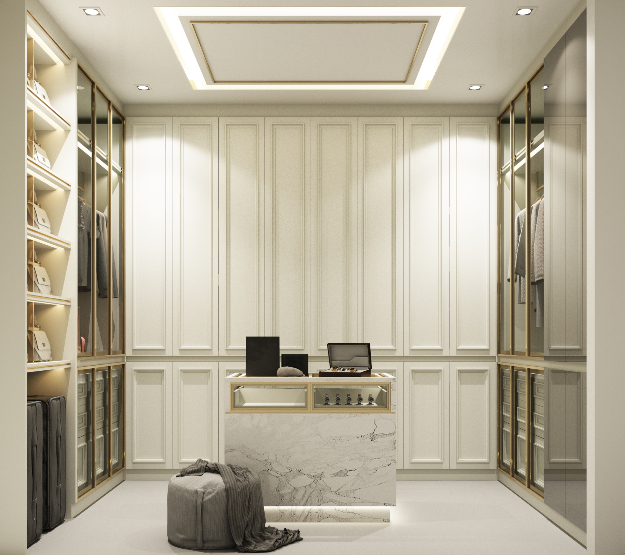Table of Contents
After identifying where to place your fitted wardrobe, the next crucial step is selecting the best material for constructing it. With several alternatives to be had, making a decision can be overwhelming. To help you with this method, we’ve prepared a complete manual on built-in wardrobe materials, outlining their pros and cons and issues for selecting the proper one that suits your desires, style, and budget.
What Are The Materials Used For Fitted Wardrobe Manufacturing?
Plywood
Plywood is made from layers of wooden veneers glued together, offering strength and stability to the wardrobe. It is a suitable fabric for low-moisture regions and is frequently completed with laminate or veneer.
Pros
- It offers proper strength and durability.
- Resistant to warping and shrinking.
Cons
- It may be more steeply priced than a few other materials.
- More eco-friendly than a few options.
Particle Board
Particle board is lower-priced and environment-friendly, crafted from wood that remains compressed into smooth sheets. It is an excellent choice for portrayal and decorative finishes
Pros
- Cost-effective.
- Suitable for various finishes and patterns.
- Environmental friendly as it uses timber waste.
Cons
- Prone to damage from moisture.
- Short-lasting compared to other materials.
Medium Density Fiberboard (MDF)
MDF is some other green material crafted from breaking down timber residuals into wooden fibres and binding them with resin. It is denser than particle board but less durable.
Pros
- Smooth floor for painting and finishing.
- More uniform and regular compared to herbal timber
Cons
- Not suitable for areas with excessive moisture.
- It may no longer be as durable as plywood or stable wood.
Glass
Glass provides a unique and stylish look for wardrobes. It can be clear, frosted, or displayed with various designs to suit your style.
Pros
- It reflects light, making the room appear extra spacious.
- Adds modernity and sophistication.
- Easy to use and maintain.
Cons
- Lack of privacy, as the wardrobe’s contents are visible.
- Susceptible to breakage if handled appropriately
Wood Plastic Composites (WPC)
WPC is a low-preservation and water-resistant craft combining wooden fibre and thermoplastics. It is a green choice but may be vulnerable to sluggish decomposition.
Pros
- Eco-friendly.
- Water-resistant, suitable for humid areas.
- It can mimic the advent of natural wood.
Cons
- It may not be as long-lasting as stable timber.
- Limited range in terms of finishes and patterns.
Solid Wood
Solid wood is a classic and sturdy preference, presenting natural splendour and attraction to your wardrobe.
Pros
- High sturdiness and toughness.
- It adds a feel of warmth and elegance to any room.
- It can be refinished and polished to maintain its look.
Cons
- They are usually extra expensive in comparison to other materials.
- Susceptible to contraction due to changes in humidity.
Metal
Metal wardrobes are an elegant and cutting-edge alternative, adding an ambitious and highly-priced look to any room.
Pros
- Sleek and present-day layout.
- Resistant to wear and tear.
- Provides an industrial and contemporary aesthetic.
Cons
- It may no longer match every home fashion or interior theme.
- It can be more luxurious than other substances.
Acrylic
Acrylic gives a unique and stylish finish reminiscent of glass but without fragility.
Pros
- It resembles glass but is more durable.
- Comes in various colours and designs.
- Easy to smooth and keep.
Cons
- It may not offer the same degree of transparency as glass.
- It can be prone to scratches and require cautious handling.
Melamine OR Laminate
Melamine or laminate finishes are cost-effective, water-proof, and available in various colours and designs.
Pros
- Budget-friendly
- Resistant to water and easy to clean.
- Versatile in terms of finishes and designs.
Cons
- Prone to scratching and chipping.
- Lower-stop types may also seem cheap.
Considerations For Choosing Wardrobe Material
Budget: Build a fitted wardrobe on budget constraints and select a material that fits within your budget range. Measure your wardrobe space to get the ideal size. Plywood and particle board tend to be extra low-cost, even as stable wood and metallic may be expensive.
Style and Aesthetics: Choose that enhances your interior and the general aesthetics of the room. Glass and acrylic offer a cutting-edge and stylish appearance, even as wood gives off a conventional and timeless enchantment.
Durability: Consider approximately the cloth’s durability, mainly if the wardrobe may be in a high-visitors place or exposed to moisture. Solid wood and plywood are long-lasting options, while glass and acrylic may require more care.
Environmental Impact: Consider the environmental impact of the fabric you choose. Materials like plywood and MDF are eco-friendly as they use wood residuals, even though plastic-based substances like WPC may have a slow decomposition quality.
Moisture Resistance: If the wardrobe can be in a moist vicinity, like a restroom, opt for materials that might be moisture-resistant, which include plywood or WPC.
Customisation: Choose a wardrobe material that allows for customisation and several finishes to complement your layout choices.
Conclusion
Selecting the quality fabric for your built-in wardrobe requires careful attention to factors like price range, fashion, durability, and environmental effects. Each material has pros and cons; the choice ultimately depends on your needs and possibilities. Considering these references and exploring unique materials, plan your wardrobe to create a functional and aesthetically beautiful wardrobe that suits your house perfectly.















